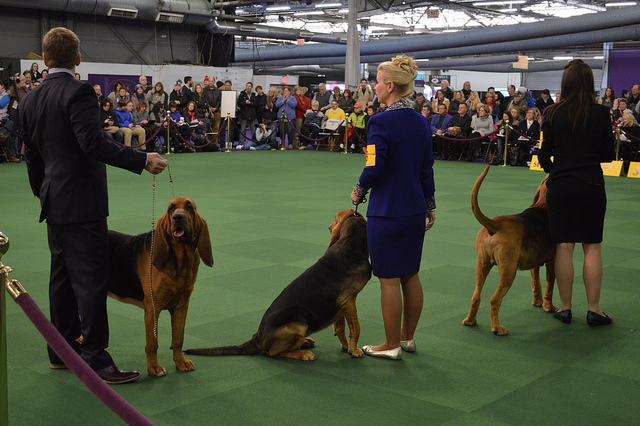
It was a dramatic night at the Westminster Kennel Club Dog Show. CJ, a three-year-old German shorthaired pointer, pulled off an upset to steal Best in Show from Rumor, a German shepherd and the presumed heir apparent to the title.
And that was just on stage. Bryan Armen Graham, deputy sports editor of The Guardian U.S., was there in the benching area below the stage, where he broadcast a pre-show on Periscope and Facebook Live for viewers at home. His reports showed a backstage area packed with hundreds of dogs, dog aficionados, dog handlers, and owners, plus a surprising amount of pizza.
It was all part of the latest Guardian Mobile Innovation Lab experiment — to test livestreaming technologies and uses for events. The Mobile Innovation Lab, which launched this fall, has previously experimented with chat apps like WhatsApp, and will be building and testing new products and experiences over the course of its two-year, $2.6 million grant from the Knight Foundation. (Nieman Lab is partnering with The Guardian to share their findings; we also receives funding from Knight.)Tuesday’s experiment sought to test the workflow, capabilities, and effectiveness of multiple livestreaming technologies as supplement to regular reporting. Graham singlehandedly filmed the Facebook Live and Periscope reports before the show began, and then liveblogged the event for the Guardian website before writing his followup coverage.
Graham and the Mobile Innovation Lab team decided to center their latest experiment around the dog show for a few reasons, according to Lab editor Sasha Koren. “We had wanted to do a sports-oriented event in coordination with the team covering sports here at The Guardian U.S. But focusing an experiment on the Super Bowl was impractical for resource reasons. This is an event we would normally cover, but also wasn’t something with incredibly high stakes on the news agenda.”
After all, when experimenting, some things are bound to go awry. The original plan, says Koren, was to use Periscope on the first night of the two-night event, and Facebook Live on the other. Because of an unforeseen amount of crowding backstage on the first night, the team scrapped its original plan, recognizing that they probably wouldn’t get what they wanted. Instead, they used both technologies on the second night with one following the other. On Periscope, Graham did an interview followed by a walk around the backstage area. His broadcast for Facebook Live followed up on the earlier report, and gave a broader look at the world behind the scenes.
Facebook Live, which rolled out last summer for celebrities and verified organizations, has quickly become a popular choice for newsrooms looking to do behind the scenes or more informal coverage. Al Jazeera English, PBS Newshour, BBC News and many others have all experimented with the capability, which has one important edge over Periscope: Its videos do not disappear after a set amount of time.
The Guardian has used Periscope before, but not in conjunction with Facebook Live. In April last year, they interviewed then presidential candidate Rand Paul on the app. This experiment was designed to test the differences between the two technologies and see how a reporter, who had used them before was able to use them in the course of their report. “We’re interested in what it takes for a newsroom staffer to do things that look, on the surface easy, but outside regular work patterns,” Koren said. “And what does it take to bring in new audiences from these services?”
Deciding to capture the events on Periscope and Facebook Live was also about the realities of The Guardian’s penetration of these apps currently, said senior product manager Sarah Schmalbach. “When we first started the Lab, we narrowed down our scope to a number of categories where we wanted to test ideas and assumptions, and livestreaming was one of them. We looked at the major platforms on which newsrooms are livestreaming, like Snapchat, Periscope, and Facebook Live, and made a decision based on the existing followers and audience we had.”Without a strong Snapchat presence, the team decided to use Graham’s Periscope account, which after a few earlier uses had gained over 1,000 followers, and The Guardian U.S.’ sports Facebook page. Graham’s Periscope registered 144 viewers for the livestream and 22 viewers who watched in the hours following. The Facebook Live broadcast registered a rough average of 30 viewers at a time watching live, but was watched several hundred times by midday the next day. Despite filming relatively similar scenes, the differences in engagement were interesting. On Periscope, Graham, visibly trying to keep the camera up as he made his way through the throngs, answered viewer questions about his favorite dogs, the history of the show, and “Where is the Bichon Frise?”
There was a lot more engagement initially on Periscope,” says Graham. “The Facebook Live is a little bit newer to me.” From the outside, the Facebook Live experience felt more of a guided tour, where the viewer still has the “exclusive” behind the scenes look, but without necessarily any say in where they were going.The team is still sifting through the data gleaned, but can see the connections to how this might be useful in further event coverage. There’s an easy connection to make with political coverage — for example, looking at what happens at political rallies,” says Koren. “Any instance where there is a live component, this could be a different experience to offer than, say, a nicely-cut video.”
This option seems to have worked out well, though. Says Schmalbach: “Dogs and the internet are always a good combination.”